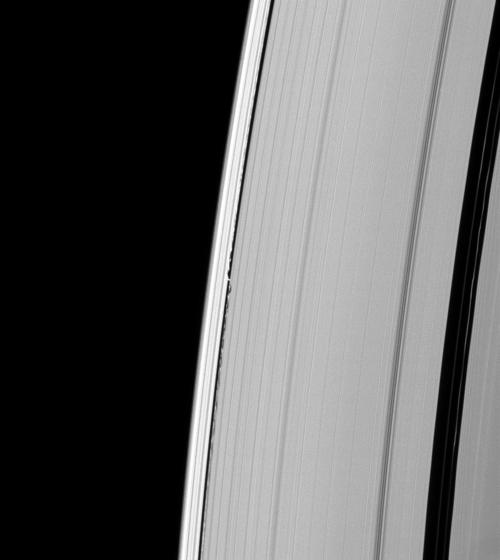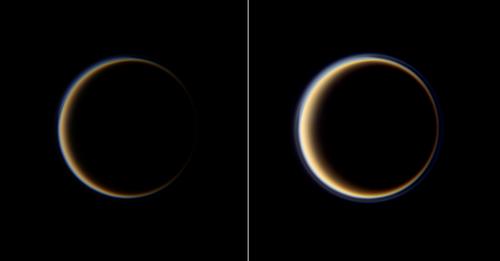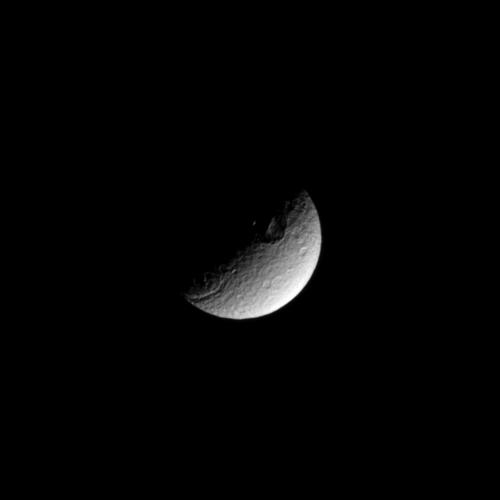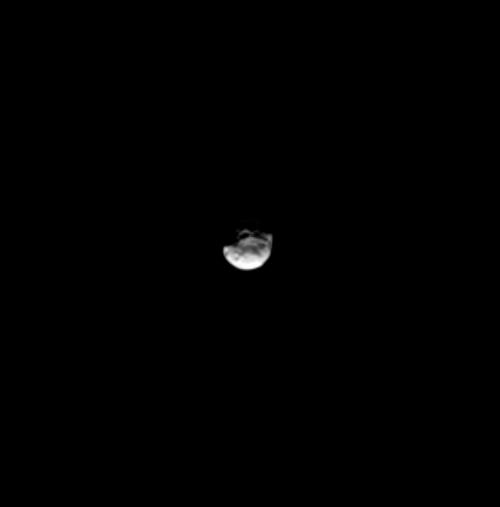Undulations mark both sides of the path of Saturn's moon Daphnis through the A ring.
Daphnis may be small at only 8 kilometers (5 miles) across, but the moon's gravity is great enough, and the Keeler gap in which it resides is narrow enough, so that the perturbed particles create the wavelike patterns seen here.
This view looks toward the unilluminated side of the rings from about 47 degrees above the ringplane. The image was taken in visible light with the Cassini spacecraft narrow-angle camera on Feb. 21, 2009. The view was acquired at a distance of approximately 1.1 million kilometers (684,000 miles) from Daphnis and at a Sun-Daphnis-spacecraft, or phase, angle of 50 degrees. Image scale is 7 kilometers (4 miles) per pixel.

Credit: NASA/JPL/Space Science Institute
Spokes at Sunrise
Bright spokes emerge from behind the shadow of the planet and into sunlight in this view from the Cassini spacecraft. Saturn's long shadow covers the left side of the image. This view looks toward the sunlit side of the rings from about 22 degrees below the ringplane.
The image was taken in visible light with the Cassini spacecraft wide-angle camera on Feb. 26, 2009. The view was acquired at a distance of approximately 821,000 kilometers (510,000 miles) from Saturn and at a Sun-Saturn-spacecraft, or phase, angle of 150 degrees. Image scale is 46 kilometers (29 miles) per pixel.

Credit: NASA/JPL/Space Science Institute
Saturn's Tortured Ring
The fragile F ring bears the signs of a moon's bruising passage.
The A ring and its Keeler Gap sit idly by on the right of this image, but on the left dark lines cut across the F ring and mark where the moon Prometheus has gored the ring and gravitationally drawn streamer-channels of material from the ring . To the left and right of the bright core, the F ring also displays the ghostly stands of its spiral arm which winds around the planet like a compressed spring.
This view looks toward the sunlit side of the rings from about 11 degrees below the ringplane. The image was taken in green light with the Cassini spacecraft narrow-angle camera on March 2, 2009. The view was acquired at a distance of approximately 1.2 million kilometers (746,000 miles) from Saturn and at a Sun-Saturn-spacecraft, or phase, angle of 33 degrees. Image scale is 7 kilometers (4 miles) per pixel.

Credit: NASA/JPL/Space Science Institute
Hazy Ring of Titan's Sky
From the dark side of Titan, the Cassini spacecraft profiles the moon's atmosphere as sunlight filters through its upper hazes. An airless satellite would appear in this viewing geometry only as a lit crescent. But Titan's thick atmosphere scatters light around all edges of the planet to create a ring of light.
Images taken using red, green and blue spectral filters were combined to create this full color view of Titan at high phase. The color in the image on the right has been computer enhanced to bring out the outer haze layer, and the contrast in both images has been enhanced. This view looks toward the Saturn-facing side of Titan. North on Titan is up and rotated 45 degrees to the left. The images were acquired at a distance of approximately 1.8 million kilometers (1.1 million miles) from Titan and at a Sun-Titan-spacecraft, or phase, angle of 157 degrees. Image scale is 11 kilometers (7 miles) per pixel.

Credit: NASA/JPL/Space Science Institute
Tethys Crater Chasm Combo
The terminator between shadow and light cuts across a large crater in the high southern latitudes of the moon Tethys. Also visible near the terminator on the left of the image is a portion of the Ithaca Chasma, a chasm that runs north-south for more than 1,000 kilometers (620 miles). This view looks toward the south pole of Tethys, and the pole lies on the terminator between the crater and the chasm.
Lit terrain seen here is mostly on the trailing hemisphere of Tethys (1,062 kilometers, 660 miles across). The image was taken in visible light with the Cassini spacecraft narrow-angle camera on Feb. 16, 2009. The view was acquired at a distance of approximately 873,000 kilometers (542,000 miles) from Tethys and at a Sun-Tethys-spacecraft, or phase, angle of 96 degrees. Image scale is 5 kilometers (3 miles) per pixel.

Credit: NASA/JPL/Space Science Institute
Janus' Pole Crater
A large crater on Saturn's tiny moon Janus is distinctly visible in this Cassini spacecraft image. Lit terrain seen here is on the leading hemisphere of Janus (179 kilometers, or 111 miles across). North on Janus is up and rotated 7 degrees to the left.
The image was taken in visible light with the Cassini spacecraft narrow-angle camera on March 5, 2009. The view was acquired at a distance of approximately 1.1 million kilometers (684,000 miles) from Janus and at a Sun-Janus-spacecraft, or phase, angle of 53 degrees. Resolution in the original image was 6 kilometers (4 miles) per pixel. The image has been magnified by a factor of two to aid visibility.

Credit: NASA/JPL/Space Science Institute





Comments